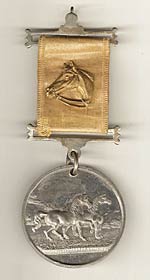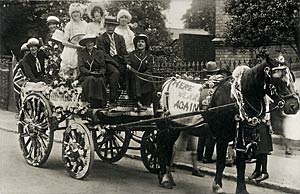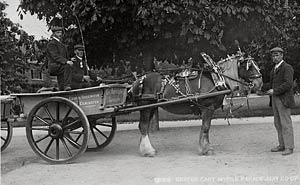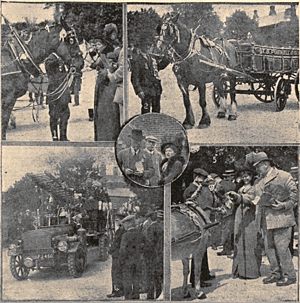
Exeter's annual cart horse parade
Page updated 2nd November 2014
Back to historic events in Exeter
 The 19th century was not
only the age of the steam engine, but it was also very much the age of
the horse. The horse was central for many businesses and for short
distance passenger journeys. The horse was of such economic importance
that many worked to improve the breeding of horses and improve their
care. With this in mind, the Exeter Cart Horse Parade was instituted to
encourage the care of the many work horses that delivered everything
from coal to beer and ferried people with horse pulled trams and
omnibuses.
The 19th century was not
only the age of the steam engine, but it was also very much the age of
the horse. The horse was central for many businesses and for short
distance passenger journeys. The horse was of such economic importance
that many worked to improve the breeding of horses and improve their
care. With this in mind, the Exeter Cart Horse Parade was instituted to
encourage the care of the many work horses that delivered everything
from coal to beer and ferried people with horse pulled trams and
omnibuses.
In January 1896, Lady Rosalind Northcote became honorary secretary of a committee to introduce a cart-horse parade in the city. It was quickly decided that it would be a holiday event, and that the first parade would be on Whit Monday. She had support from the Mayor Robert Pople, Countess Iddesleigh, Baroness Burdes-Coutts, Lady Audrey Buller, Lady Shelley, Mrs Thornton West and Mrs Quick. One wonders how much of this largesse was for the horse and how much was directed towards showing how much they cared for the working man. Whatever the motive, a series of planning meetings were held, some in the Guildhall, and the general aim of promoting the kindly treatment of horses and improve their care by their owners was formulated.
At a meeting of the 22nd February 1896 it was agreed that entry to the parade would cost 6d, and all entries had to be made by the 11th May. The parade would be open to persons within a radius of 7 miles of Exeter.
The classes were - pair draught horses in carriers wagons single heavy horse single horse in cart belonging to City, District or Parish Councils pair of brewers horses or millers contractors or builders work single horse for above single horse coal dealer and forage dealer pair of farm horses single farm horse single horse owned by single horse owner single horse in four-wheel van cob or pony pair of omnibuses cab horse donkeys The RSPCA agreed to award a diploma to all first prize winners, in addition to the cash prize. At a meeting of the 7th March the route was planned – Higher Barracks - Howell Road - Queen Street- High Street - Longbrook Street - Union Road - Tiverton Road - High Street - Exe Bridge across the West Quarter and finish in Bedford Circus.
First Parade
Whit Monday the 25th May 1896 was blessed with fine summer weather. The horses with their carts assembled in Higher Barracks and the judging commenced of the 174 entries with 200 horses, ponies and donkeys. The handlers had spent hours polishing the brass and leather of the harnesses, cleaning and painting the carts, and tying ribbons to the horses mains and tails. Many of the carts carried not only the carter, but his family as well, dressed in their Sunday best, with the addition of intricate bonnets for the ladies.
The largest horse of that first parade was an 18-1 hand, dray horse, belonging to Mr Coombe of Thorverton. The championship prize for the best turnout was T Denham of Purnell & Sons, who entered a single horse in cart, used by a coal merchant or forage dealer. His photograph was taken by Denney of the Arcade – Purnell & Son presented a copy of the photograph to Lady Northcote.
The Cart Horse Parade commenced at 10.30am, and wound its way through the streets of the city which were lined with thousands of spectators. At the end, in Bedford Circus, the prizes were awarded by Lady Iddesleigh, as the carts were paraded past an improvised platform containing Lord and Lady Poltimore, Lady Rosalind Northcote, Lady E Northcote (her mother), the Mayor Robert Pople, Colonel Leigh and Mr G F Gratwicke. The crowd first applauded when the competing horses of the Tramway Company came into view.
The success of the parade in 1896 ensured that it was repeated – by 1900, Dawlish, Exmouth and Tiverton all had their annual Cart Horse Parades, while Exeter expanded the festivities with the cycle club organising a sports day at the County Ground in the afternoon and fireworks in the evening. The day often started with a swimming gala in the new tepid swimming baths at 9am. In 1900, a gun detachment of the 120th Battery of the Royal Artillery, stationed at Topsham Barracks, headed the procession through the streets. The event even drew accusations of cheating when the Flying Post stated in 1900 that one competitor had borrowed a set of harnesses and tackle for everyday use, so that be could clean and prepare his normal working harness for the parade - "This was contrary to the spirit, if not to the words, of the rules governing the competition, for it was decidedly unfair to the men who had to exhibit their ordinary working tackle as it was used every day."
In 1914, Lady Northcote was still organising the parade, which was to be the last in Exeter, as the 1915 event was cancelled due to the war, and no attempt was made to continue after the end of hostilities. Annual parades in other Devon towns were also discontinued, with many announcements being made in the press in 1919 and 1920.
The photo above, shows the medal awarded to Hermon George Green, of Exwick, who won a second prize medal and red ribbon for his pair of horses in a cart or wagon, which was owned by J L Thomas. He also received 15s prize money. The parade was suspended for the war, and many of the carters and handlers were called up – Herman George Green became a gunner in the Royal Garrison Artillery, before he was killed in action on the 30th November 1917. One of the handlers in the photo of the City Council shire horses after the war, Arthur Burrows, was also called up to work with horses on the Western Front.
Working horses were still an important part of the economy after the First War, and there were still horse drawn delivery services from the railway stations and local depots on a regular basis to many towns and villages, until 1939. The City Council retained working horses, and horses still paraded through the city at the annual carnival, sharing the stage with cars, vans and motor lorries. But, the age of the horse was essentially over, and with it died the annual horse cart parade.
Sources - Trewman's Exeter Flying Post,Exeter and Plymouth Gazette, Margaret Jones.
 A decorated single horse cart.
A decorated single horse cart. An entry for the May 1907 parade.
An entry for the May 1907 parade.  Horses
waiting for the 1906 parade.
Horses
waiting for the 1906 parade.  Cart Horse Parade
Cart Horse Parade
Scenes during the judging in the Barrack Yard
1 Lady Rosalind Northcote presenting badges.
2 A veteran competitor with his medals.
3 The Mayor of Exeter and Lady Rosalind Northcote watching the judging.
4 The new motor fire-engine taking part for the first time in the Parade.
5 A favourite exhibit.
Exeter and Plymouth Gazette - 2 June 1914
│ Top of Page │